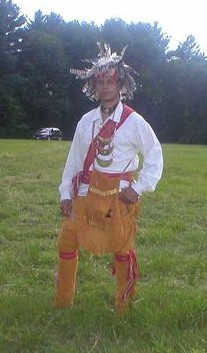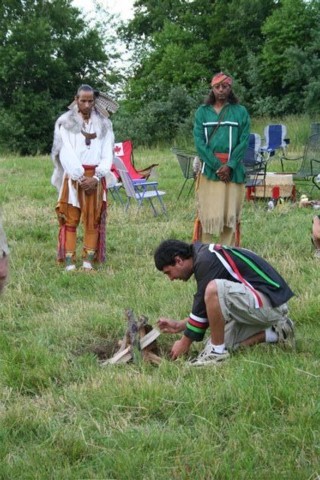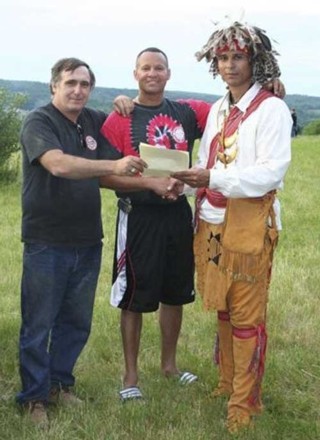“AFTER THE MAYFLOWER,” first episode in a series about Nipmuc Indians starting tonight on PBS.
 Tonight on PBS there will be the first episode in a five part series “We Shall Remain,” a look into the aboriginal inhabitants of New England.
Tonight on PBS there will be the first episode in a five part series “We Shall Remain,” a look into the aboriginal inhabitants of New England.
The language consultant for the movie is David Tall Pine White of the Chaubunagunga-maug Band of Nipmuc indians who also is a tribal council member of the confederacy of Nipmuc, (Nipmuck) indian tribes. Tall Pine lives in Brimfield. Also represented in the film is Larry Spotted Crow Mann of the historical Nipmuc tribe who is also a tribal councilor for the Nipmuc confederacy. Nipmuc territory encompasses all the land between the Charles and the Connecticut rivers east to west, and north to south from the New Hampshire boarder to the Connecticut Saffrey line.
When King Philip‘s war began in 1675, Metacomet (Philip) disappeared west into the forest and the swamps to wage his campaign against the devious Puritans. However, west of the Charles River was Nipmuc territory and the war was waged mostly in the interior. The swamps of Mashapaug were utilized as a war camp by the Metacomet and Nipmuc war chiefs.
The Nipmuc continue to bear the brunt of the backlash for the war and were almost completely exterminated. Most fled west or north after the war into Iroquois territory and those that were captured were killed or sold into slavery. Those Nipmuc who did not take part during the war were interred on Deer Island in Boston Harbor without food or shelter and perished during those winter months during Metacomets uprising. A memorial is in the works on that island for those who perished in the Deer Island Holocaust.

After King Philip‘s war at Kekamowadchaug an ancient Nipmuc plantation next to the river Manaxit in what is now known as Oxford the remnants of the Nipmuc people that have occupied central Massachusetts for over 15 thousand years were gathered in the center of their territory which was quickly being gobbled up by treacherous land dealers including John Eliot apostle to the indians and Major Gookin who accompanied Eliot on his journeys. Both were in reality land speculators who were stripping the Nipmuc of their lands and forcing them into praying towns in Natick, Grafton, Oxford, and Dudley. In 1687 a group of French Refugees fleeing after the revocation of the Edict of Nantes were given a land grant 8 miles square in the heart of Nipmuc territory encompassing what is today Oxford, Webster, with parts of Dudley, Sturbridge, Charlton, and Southbridge also being in the Land Grant. These refugees were known as Huguenots and were protestant reformists.
The word liberty was brought to the new world with the Huguenots who settled on Bondet Hill in New Oxford in the late summer of 1687.
The leader of the settlers, Daniel Bondet, was a minister who settled the grant making his home and the community meeting house on Kekamowadchaug.
The Huguenots lived in peace and harmony with the Nipmuc until the jesuits of Canada sent a raiding party of Canadien Indians into the Protestant Community of Oxford where a massacre took place and was blamed on the Nipmmuc. The Wapaquasetts tribe was also involved.
Like the Pilgrims of Plymouth who lost half their party the first winter in the new world so would our Huguenots have suffered the same fate without the maize and meat provided by the Nipmuc of Kekamowachaug.
 After purchasing the Huguenot Farm at Bondet Hill in 2002 I felt the power of the ancient plantation as it commands a 360 degree view of Nipmuc Territory with the sacred lake Cargogagogmanchaugagog- chaubunanagungamaug a little to the south.
I setout to renew old ties established in 1687 with the local Nipmuc and returned the summit of Bondet Hill to their people.
After purchasing the Huguenot Farm at Bondet Hill in 2002 I felt the power of the ancient plantation as it commands a 360 degree view of Nipmuc Territory with the sacred lake Cargogagogmanchaugagog- chaubunanagungamaug a little to the south.
I setout to renew old ties established in 1687 with the local Nipmuc and returned the summit of Bondet Hill to their people.
These Nipmuc will have part of their story told tonight on PBS, I invite you all to see the settlement of the New World from the eyes of the people who were here when the first colonists arrived. Holland is given an opportunity to pay tribute to the Nipmuc natives each September when they hold their gathering at Siog.
James LaMountain, Huguenot Farmer at Bondet Hill circa 1687